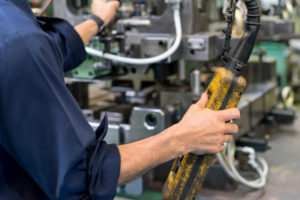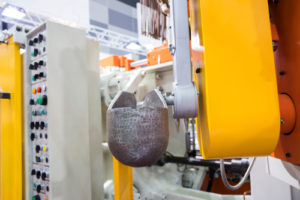 In die casting, molten metal is forced into a mold cavity under high pressure. The mold cavity is made with steel dies, which are machined into shape as well as work like an injection mold in the metallurgical process. Its output is known as a ‘casting’. Most castings are produced from non-ferrous metals, among which zinc, aluminum, and magnesium are the popular ones.
In die casting, molten metal is forced into a mold cavity under high pressure. The mold cavity is made with steel dies, which are machined into shape as well as work like an injection mold in the metallurgical process. Its output is known as a ‘casting’. Most castings are produced from non-ferrous metals, among which zinc, aluminum, and magnesium are the popular ones.
The die casting machines are of two types: cold and hot chamber. The latter relies upon molten metal ‘pool’ to feed the die. The benefits of hot chamber die casting comprise fast cycle times as well as the convenience of melting metal inside the die casting equipment. The relative downside to the hot chamber approach to it is that metals with a high melting point cannot be used in the process. Aluminum is one that cannot be utilized since it picks up some iron when in the pool of molten metal. Owing to this, hot chamber equipment is used primarily with tin, zinc, and lead-based alloys.
Cold chamber machine, on the other hand, is used with the alloy that cannot be utilized in the other type. The cold chamber die casting starts with melting metal in a different furnace. Then, a specific amount of metal in molten form is transferred into the machine, where it is fed to a shot chamber that is not heated. Then, this shot is fed into the metal die by a mechanical or hydraulic piston.
The die casting machine, as well as the dies, represent big capital costs, which then tends to restrict the metal casting to high-volume production runs. Die casting of parts is relatively easy, involving just four main steps, keeping the per-item incremental cost low. The process is suited especially for a big quantity of castings that are small to medium in size, so it makes more outputs than any other metal casting process. Die-cast parts are characterized by an extremely good surface finish as well as dimensional consistency.
Types and Applications of Die Casting
Direct injection and pore-free die casting process are two variants. While the first one is used with zinc to reduce to the scrap as well as enhance yield, the second one is employed to eliminate the gas porosity defects. Die casters revert to the best practices to provide quality outputs in quick turnaround times. Die casting is the kind of field where they are the only norm, as many sectors require die-cast parts for various applications.
Die casting offers several benefits to different clients from different sectors. The process is detailed and accurate. It offers several benefits that machined components tend not to. It is less expensive owing to rapid production runs and since the material is utilized only where it is required and as much as is necessitated. The process offers a fine mix of mechanical properties, dimensional consistency, and surface finish, which provides for a better output at a much lower cost.
Die casting is not just a more reliable choice, it also offers a significant chance for cost savings. They could be eighty percent or more as opposed to common machining costs. Besides, die casting  offers a major cycle time reduction. For instance, a component might be die cast once every minute, while machining produces 2 to 10 components per hour.
offers a major cycle time reduction. For instance, a component might be die cast once every minute, while machining produces 2 to 10 components per hour.
Radii and draft angles have to be integrated into the final product design. Thus, it is essential to work with an expert die casting company early during this stage. The die-cast designs’ one major advantage is that the process lets you have a component wall thickness of around 2.5 millimeters or less while at the same time having exceptional tensile strength.
Another advantage of the die casting process is excellent repeatability. It can make thousands of similar parts in specific tolerances before extra tooling may be necessitated. Even if replacement is ultimately required, the whole die does not necessarily have to be replaced; oftentimes, only specific sections have to be repaired or replaced.
Die-Cast Components
Die-cast components are used for everything from standard automobiles to marine applications to toys and space shuttle prototypes. It is one of the quickest and cost-effective production processes for an array of parts. However, to achieve the maximum benefits from die casting, it is vital that designers team up with die casters at an early phase of the product’s design as well as development.
Consulting with an experienced die caster at Pacific Die Casting during this design phase will help in resolving issues that affect tooling as well as production, while at the same time identifying the diverse exchanges that could influence total costs. For example, components that have external undercuts often necessitate dies with slides. It increases the tooling cost but may lead to reduced use of metal, uniform component wall thickness or other benefits. These savings will likely offset the tooling cost, depending on the production quantities, which provide overall economies.
